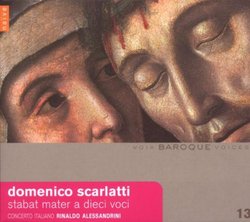| All Artists: Domenico Scarlatti, Rinaldo Alessandrini, Andrea Perugi, Elena Cecchi Fedi, Elisa Franzetti, Elisabetta Tiso, Rosa Dominguez, Gianluca Ferrarini, Paolo Fanciullacci Title: Domenico Scarlatti: Stabat Mater a Dieci Voci Members Wishing: 0 Total Copies: 0 Label: Naive Release Date: 10/30/2007 Genre: Classical Styles: Opera & Classical Vocal, Chamber Music, Historical Periods, Baroque (c.1600-1750), Classical (c.1770-1830) Number of Discs: 1 SwapaCD Credits: 1 UPC: 709861304462 |
Search - Domenico Scarlatti, Rinaldo Alessandrini, Andrea Perugi :: Domenico Scarlatti: Stabat Mater a Dieci Voci
 | Domenico Scarlatti, Rinaldo Alessandrini, Andrea Perugi Domenico Scarlatti: Stabat Mater a Dieci Voci Genre: Classical
|
Larger Image |
CD Details |
CD ReviewsLike Father Like Son? Not Much! Giordano Bruno | Wherever I am, I am. | 03/05/2009 (5 out of 5 stars) "Alessandro Scarlatti's setting of the Stabat Mater is a model of Baroque emotional expressiveness, essentially an operatic cantata, with the sectional variety of recitations and arias over basso continuo that Vivaldi had employed in his earlier setting and that Pergolesi was soon to use in his. Whether Domenico Scarlatti intended his remarkable Stabat Mater for Ten Voices to be taken as a sign of his independence from the model of his father, or a response to a commission from the Duke of Alba, or a challenge to the 'theatrical' composers of the musical moment who lacked 'the true laws of writing in counterpoint,' the younger Scarlatti chose to compose in the strictest "prima prattica" style of vocal polyphony with minimum continuo, a form of music closer to Palestrina or Brumel than to his 18th Century peers. The ten voices are not even grouped into two choirs in the antiphonal manner of Gabrieli, and they double up as a choir of part parts only for brief sectional emphasis. Young Domenico clearly seems to have intended to prove something; this is true ten-part polyphony that any Renaissance master would have had to admire.
The Mass for Four Voices is possibly even more a piece of defiance, a challenge to composers of popular but shallow music to match the higher standards of previous eras. The only source of the work, dated 1754, is a manuscript copied in a graphic style plainly imitative of the elegant part-books of the Renaissance. Thus the "most modern" composer of his age, so christened by modern worshipers of his keyboard works, was also the most "reactionary!" I've given myself the pleasant task of surveying the great Stabat Mater settings of the 18th Century - by Vivaldi, Alessandro Scarlatti, Pergolesi, Bononcini, and Haydn - all of them works for solo voice or voices with instrumental support. This ten-part archaic Stabat Mater by Domenico is of such a different musical style and emotional affect that it seems utterly timeless, a meditation on sorrow rather than a depiction. The performance by Concerto Italiano, directed by Rinaldo Alessandrini, is heavenly; this is an ensemble that has specialized in the soloistic, operatic repertoire of the 17th and 18th Centuries, but their restrained and balanced singing of Scarlatti's anachronistic polyphony makes me wish they'd turn more attention to earlier masterworks. I'd love to hear them sing Brumel's 12-voice Missa Et Ecce Terrae Motu!" |

 Track Listings (16) - Disc #1
Track Listings (16) - Disc #1